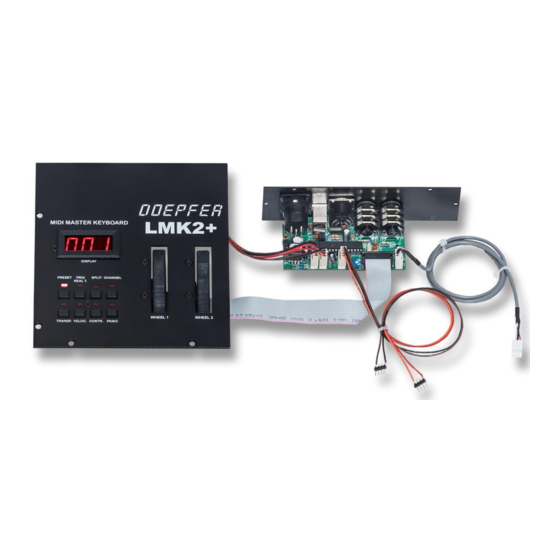DOEPFER LMK2+ Benutzerhandbuch - Seite 8
Blättern Sie online oder laden Sie pdf Benutzerhandbuch für Elektronische Tastatur DOEPFER LMK2+ herunter. DOEPFER LMK2+ 12 Seiten. Midi master keyboard usb version
Auch für DOEPFER LMK2+: Schnellstart-Handbuch (6 seiten)

Sending a realtime instruction
The upper three white keys of the lowest octave are assigned to the real time instructions START (G), STOP
(A), and CONTINUE (H). If one of these three keys is pressed while beeing in menu 2 the corresponding
realtime instruction is sent. An abbreviation of the message will appear on the display for several seconds
("StP", "StA", "CON"), then the keyboard goes into PLAY-mode. Pay attention that LMK2+ transmits only these
three real time events. No clock events i.e. tempo information is sent!
7.3.3 SPLIT (3)
Third button in the upper row
The SPLIT-menu serves to define the keyboard zones, i.e. the lowest/highest key for each of the 4 zones. When
entering this menu the LED display will show the number of the currently selected keyboard zone, followed by
"LO". The message "LO" is meant to prompt the user to press the lowest key for this keyboard zone. Once a key
has been pressed the display will show "HI", meaning that the user should now press the highest key for the
keyboard zone. Once this has been accomplished the keyboard will return to PLAY-mode.
7.3.4 CHANNEL (4)
Fourth button in the upper row
This menu serves to set the Midi-channels for the 4 keyboard zones. When entering this menu the number of
the currently selected keyboard zone is shown on the left side of the display, the corresponding Midi-channel is
displayed on the right side. In order to set the Midi-channel one must press one of the keyboard keys which
have been assigned the numbers 1 through 16 (starting with C of the second octave). After the Midi-channel
has been entered the keyboard will return to PLAY-mode.
7.3.5 TRANSPOSE (5)
Leftmost button in the lower row
This menu serves to define the transpositions of the 4 keyboard zones. The number of the currently selected
keyboard zone is shown on the left of the display, followed by "FI". "FI" stands for "First" and prompts the user to
enter the first key (= reference key) for the transposition. After pressing the desired key the display changes to
"SE", prompting the user to press the second key needed for calculation of the transposition. For example, in
order to achieve an upward transposition of one octave, one must press any key and then press the same key
one octave higher. In order to achieve a downward transposition of a semi-tone one must press any key
followed by the next lower key. In order to cancel a transposition one must press the same key twice. Please
note that each transposition is calculated from scratch, there are no additive effects from or references to earlier
transpositions. Otherwise it would become quite difficult to remember what sort of transposition is actually in
effect after several have been made. After the desired pair of values for the keyboard zone in question have
been entered the keyboard goes into PLAY-mode.
7.3.6 DYNAMIC (6)
Second button in the lower row
This menu serves to assign velocity-response curves to the 4 keyboard zones. When entering this menu the
number of the currently selected keyboard zone is shown on the left side of the display, the corresponding
velocity-response curve (1...16) on the right. Information on the use of the velocity-response curves can be
found in Appendix A. The curves permit the user to adjust his/her personal keyboard touch to the electronic
response of the keyboard, as well as the implementation of key pressure-controlled blend-over effects
("Crossfade"). In order to assign the desired velocity-response curve to a keyboard zone one must press one of
the keys on the keyboard which have been assigned the numbers 1 - 16. Afterwards the keyboard will go into
PLAY-mode.
LMK2+/USB User's Guide Page 8
